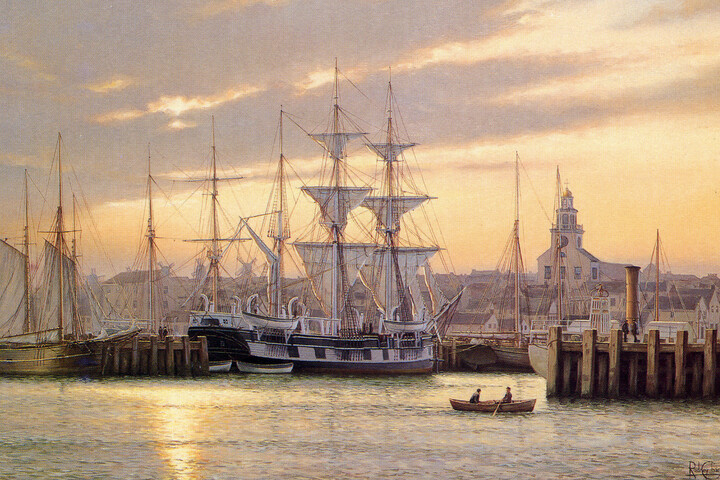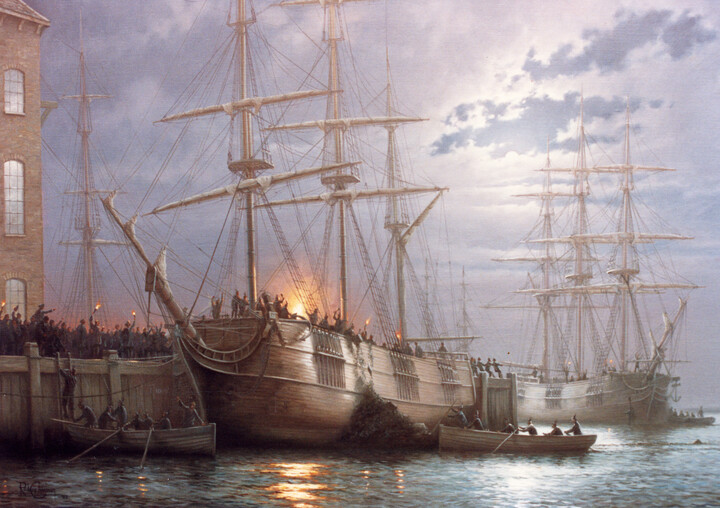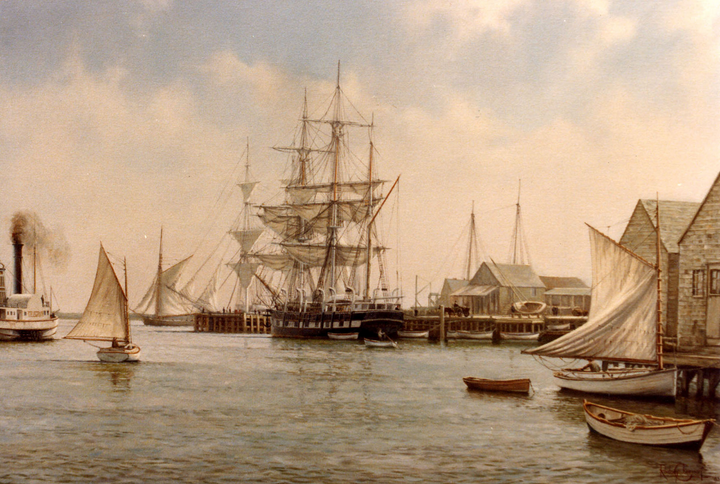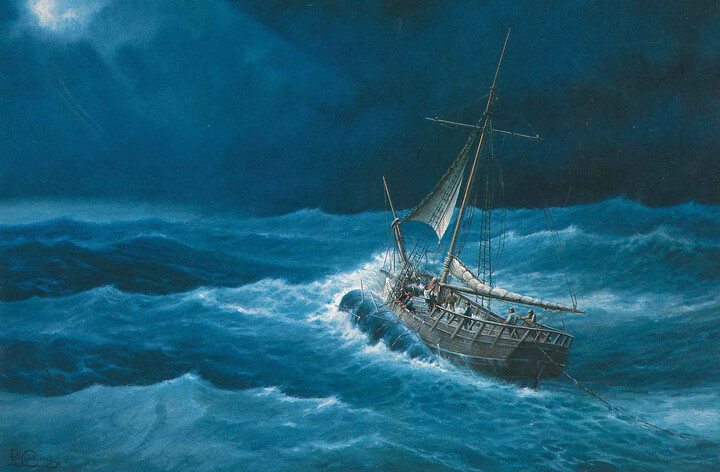
Marine Artist Rodney J. K. Charman Was Commissioned by Egan Maritime Founder, Bud Egan, to Paint Nantucket's Early History
By Michelle Cartwright Soverino
From the founding of the island in 1659 until the nineteenth century, more than 200 years of Nantucket history were never recorded by artist or camera. Only the scrimshaw of whalemen existed to depict the Golden Age of Whaling or scenes from early Nantucket. By the mid-1980s, few artists ever captured the local views and activities of island days of yore. Wanting to illustrate Nantucket’s significant moments in history, Egan Maritime founder, Albert F. “Bud” Egan, turned to art. It was his desire to capture some essence of Nantucket’s seafaring stories.
During the early 1980s, Egan, accompanied by his wife, Dorothy, traveled to the United Kingdom. There, they met marine artist, Rodney J. K. Charman, and Egan was impressed by the artist’s exhibited works. “He was the sort of person who would make things happen,” said Charman. “When he had a vision to set up a museum to celebrate the maritime history of the Island he was looking for artists to document the past and his search brought him to the U.K. where he saw my work in a marine art exhibition in 1984. He was obviously taken with my work as, on his return to the island he phoned me one night to invite me over the Atlantic to discuss and research possible subject matter.”
Always wanting to find an artist to help him achieve his vision of a body of painted works that represented the island's history, Egan inquired with Charman about commissioning historic paintings after his return to Nantucket. In recent correspondence with Charman he wrote, “Mr. Egan’s habit was to make his business calls in the evening after a day on the golf course. With the time difference his calls to me would be late evening and you can imagine what it was like for me to receive a call, late at night, from across the Atlantic asking me to visit the legendary Island of Nantucket.” Charman accepted and soon traveled to the island.

Bud and Dorothy Egan in England.
Rodney J. K. Charman was born in 1944, near the town of Lymington, England, where he has lived all his life. His career in painting began at the age of twenty-one when he received a set of oil paints for his birthday. With no formal art training, Charman began his art career as a self-taught painter, always working in oils and in his own natural style. From the portrayal of varied subjects, including landscapes, portraits and equestrian studies, he soon returned to his first love: ships and the sea. Once he found his true talent for the marine scene, his future was established.

Artist Rodney J. K. Charman working in his studio in Lymington.
It was Charman’s immersive creative process and keen eye for minute touches that solidified his relationship with Egan, and no doubt impressed him. “From the start,” said Charman, “Mr. Egan and his wife, Dorothy, made me feel completely at home.” Indeed, Egan welcomed Charman into his own unique Nantucket. The artist had already become an integral part of his legacy. “Mr. Egan was always extremely proud of his Island home. On my frequent visits he would always go for a drive and every time it would be somewhere interesting and unusual and always places that were new to me. If I had friends, family or acquaintances on holiday in New England, he would arrange to have them flown over and would treat them to lunch and a tour of the Island,” said Charman.
Egan’s relationship with Charman began with a short series of works. “The idea was for me to complete two paintings out of a series of eight that he had outlined. He introduced me to important and knowledgeable people including the great Nantucket historian Edouard A. Stackpole, and to the research facilities at the Nantucket Historical Association. I returned home with plenty of information and bustling with thoughts. Mr. Egan visited the UK again a short time later where I met up with him to discuss my ideas and to go over sketches that I had prepared.”

Albert F. "Bud" Egan proudly stands by a Charman painting in his office.
From then on, the relationship between the artist and his Nantucket patron was indestructible “I completed two paintings,” said Charman, “and went on to paint eight subjects and around fifty more. Mr. Egan was well versed in the island’s history and would be the instigator for most of the subjects I covered. The paintings were exhibited in the old Coffin School—Mr. Egan had been a pupil there decades before—where he set up his museum and later the Egan Foundation, today known as the Egan Maritime Institute.”
When Charman’s first Nantucket works were displayed on the island at the Coffin School, they received a favorable response. Noted Charman, “there was no looking back after that,” and Egan soon commissioned the artist to research and produce more paintings of important events in Nantucket history—bringing his desire to curate a collection of island works to fruition. The complete series of Charmans recaptures the great events of Nantucket history and brings them to life through the skill of a great artist. In 1989 Egan, along with friend and island historian, Robert F. Mooney, published a selection of Charman’s paintings with Egan Maritime’s Mill Hill Press, titled, Portrait of Nantucket, 1659 – 1890.

Rodney Charman, The Boston Tea Party. Egan Maritime Institute collection.
In addition to his many works on Nantucket, Egan also commissioned Charman to paint other historic moments that he had a deep personal relationship with. “Mr. Egan also remembered his Irish heritage and bought a collection of 23 paintings that I had produced for a book called The Famine Ships, depicting the ships that brought the immigrants from Ireland, and he arranged for them to be exhibited at the South Street Seaport Museum in New York,” said Charman. Serendipitously, one of Egan’s commissions, a painting of the ill-fated Irish passenger ship, British Queen, will be the focal image for the Nantucket Shipwreck & Lifesaving Museum’s 2019 special exhibition, When All Hope Had Died. It seems that Egan was far ahead of his organization, for the then Nantucket Lifesaving Museum was at least a decade away from becoming part of Egan Maritime Institute at the time of the painting’s commission.
Charman’s best works demonstrate the glory of historic sailing ships and scenes—the clipper ships, the whalers, and the working schooners of the 19th century. His paintings are the product of meticulous research and attention to detail. To accomplish their accuracy and splendor, Charman travels extensively. It is his mission to provide authenticity in his work, best cultivated through an intense study of marine subjects. His honors include selection for the International Maritime Arts Awards Show in Mystic, Connecticut, a profile in the definitive work, 20th Century British Marine Painting, and successful one-man exhibitions in Lisbon, Portugal, and on Nantucket. Pursuing his other maritime interests, he has gained practical experience aboard the sailing schooner Malcolm Miller and on the X-Boat racing yachts in his home town of Lymington.

Rodney Charman, Old North Wharf - 1850. Egan Maritime Institute collection.
For Nantucket, Charman is known as the artist who gave the island its portrait. His preliminary meeting with Egan led to an island narrative told through art. Reflecting on Egan, Charman noted, “He loved Nantucket and everything he did was for the good of the community.” By the end of his life, Egan was a great benefactor of art on Nantucket and there is no doubt that he left an impressive collection of art for the island. He also greatly impacted a select group of artists, on and off the island, who were able to establish vibrant careers thanks to his patronage. “I feel privileged to have known him,” said Charman, “he was a wonderful host and patron and I miss his charm and humor.”
A Selection of Charman's Works From "Portrait of Nantucket, 1659 - 1890"
Narratives written by the late Robert F. Mooney.

Rodney Charman, Landing of the First Settlers at Madaket – 1659
Egan Maritime Institute collection.
Following the initial expedition to the island in 1659, the first permanent settlers, including some of the original proprietors and ten additional families, arrived in Madaket Harbor in the summer of 1660. In keeping with their plans to establish an agricultural community, they brought with them the first sheep to inhabit the Island – animals they believed would best adapt to the local climate and topography. Making their first permanent settlement at Capaum Pond, where a small harbor and fresh water supply was available, these first settlers won the hearts of the native Indians by their missionary activity and fair dealings. In so doing, this new colony was able to commence its career with a spirit of harmony and cooperation between the races.
Rodney Charman, King Philip at Altar Rock – 1665
Egan Maritime Institute collection.
Surrounded by gently rolling heath lands at the highest point on the island – 100 feet above sea level – Altar Rock was, according to legend, a sacred place to Nantucket Indians. It was there, at Altar Rock in 1665, that the Wampanoag sachem, Metacom – also known as King Philip – threatened to execute the English speaking Indian Assassamoogh – also known as John Gibbs – for speaking the name of Philip’s dead father – taboo in Wampanoag culture. This scene captures the moment in which King Philip stands with his prisoner at Altar Rock, the settlers intervene by offering a ransom and John Gibbs is spared.

Rodney Charman, Taking of the First Sperm Whale Off Nantucket – 1712
Egan Maritime Institute collection
Whaling began from Nantucket in off-shore boats as early as 1672, when the early colonists learned the practice from the Indian inhabitants of the Island. These small drift whales, which seasonally frequented the shores, awakened the Nantucket interest in the business of killing whales and extracting their oil. It was not until the mariners went further off shore to find the great whales that the enterprise began to prosper. The first great event occurred in 1712, when Captain Christopher Hussey, while pursuing right whales, was driven out to sea by a strong gale off the Nantucket South Shoals. When the storm cleared, he sighted a number of whales, distinguished by having a tall single spout instead of the familiar forked spout of the right whale. Hussey gave pursuit in an open boat and killed the first whale. This proved to be a huge mammal with a great long body, enormous head, and rows of teeth in its lower jaw. Inside the head he was amazed to find a treasure of sperm oil, the marvelous oil which proved to be the best lighting fluid in the world. This event marked the first time a Nantucket ship had taken the mighty sperm whale - the aristocrat of all whales and the foundation of the great days of the Nantucket whaling era.

Rodney Charman, Fitting Out – 1843
Egan Maritime Institute collection.
By the 1830s and ‘40s, Nantucket had become a thriving commercial center and the third largest port in New England. Ships crowded the harbor, as the town bustled with whaling related industries, including seventeen oil factories, nineteen candle manufacturers, ten ropewalks, and twenty-two cooperages. In addition, stately homes with gardens were being built on Main Street, adding to the general air of prosperity.
Depicted in its preparations for going to sea, the whaleship Rambler, is shown here tied up at South Wharf in June 1843. Under the direction of Captain Robert McCleave, the ship sailed for the Pacific in July of that year. To the right, tied up at Straight Wharf is another whaleship, Ploughboy, captained by Moses Brown.

Rodney Charman, Opening of the Nantucket Railroad – 1881
Egan Maritime Institute collection.
This dramatic scene depicts one of the most colorful events in Nantucket History – the inaugural trip of the Nantucket Railroad, which took place on schedule, July 4, 1881. Inspired by local promoters and mainland investors, the railroad ran on a narrow-gauge track. It was designed to run from Steamboat Wharf, along Easy Street and Washington Street and thence out to the booming village of Surfside, three miles away, with a later extension to Siasconset. Featuring a single engine named Dionis, for Tristram Coffin’s wife, and two passenger cars, the road proved to be a popular tourist attraction during the summer for several years. It was also a thrill for the islanders, many of whom had never seen a train before. In later years, the little railroad became the victim of storms and surf, which washed away the tracks to ‘Sconset, and to declining revenue which followed the arrival of the automobile. The road was finally torn up and sent to France to aid the Allies in World War I. Yet for many Nantucketers, the colorful years of the Nantucket Railroad were a journey which will never be forgotten.